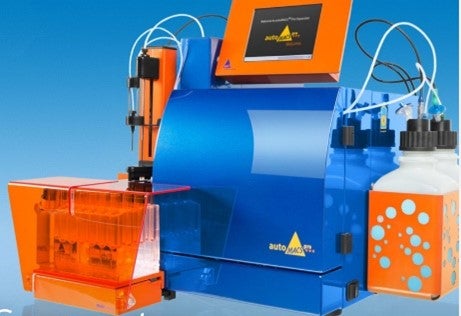NUS-Cambridge Immune Phenotyping Centre

About NUS-Cambridge Immune Phenotyping Centre (NCIPC)
The centre was established in July 2022 and is led by Associate Professor Paul A. MacAry, Director of Life Sciences Institute (LSI), at the National University of Singapore (NUS) and Professor Ken Smith, Director of Cambridge Institute for Therapeutic Immunology and Infectious Disease (CITIID), at the University of Cambridge. NCIPC is an advanced, comprehensive immune, metabolic and microbial phenotyping platform that exploits advances in high-dimensional flow cytometry, massive parallel sequencing, microbiome metagenomics, proteomics, and single-cell transcriptomics to map cellular and molecular pathways in human health and disease and in patients with a range of diseases and subject to various therapeutic interventions.
The platform at NUS is a mirror-image to the Cambridge BRC Cell Phenotyping Hub at the University of Cambridge. Both sites have identical equipments, methods and workflows, in order to simultaneously run and generate standardised data that can be directly comparable to cohort studies at both sites. The centre serves as a focal point for research collaborations between basic and clinician scientists and industries aiming to investigate Asian and Caucasian phenotypes within Singapore and Cambridge. The centre is managed by Dr Karishma Sachaphibulkij and a scientific team of experts.
Vision
- To provide state of the art high quality, cost-effective technological expertise and services across the wide range of cytomics and deep immune phenotyping in healthy controls and in patients with a range of diseases and subject to various therapeutic interventions
- To generate standardized data that can be directly comparable to the European cohort in Cambridge BRC Cell Phenotyping Hub.
- To serve as a focal point for research collaborations between basic and clinician scientists within Singapore and from Cambridge.
The platform is equipped with state-of-the-art analysers and cell sorters and are listed below:
Booking of machines
Approval from the NCIPC lab is first needed before you can register to make bookings on the analysers. You can consult the calendars for when time is available on the cell sorters but always contact the lab members directly before making a booking.
Lab operating hours
Monday to Friday: 9am to 6:30pm, excluding public holidays.
After hours: Upon approval from Dr Karishma.
Usage charges
Please contact us directly for machine usage charges.
 Contact person: Dr Karishma Sachaphibulkij
Contact person: Dr Karishma Sachaphibulkij
PhD
Manager, Research Fellow
NUS-Cambridge Immune Phenotyping Centre, 28 Medical Drive,
Centre for Life Sciences, #03-05B
Singapore 117456
Email: karishma@nus.edu.sg
 Contact person: Anita Balakrishnan
Contact person: Anita Balakrishnan
Administrative Manager
NUS-Cambridge Immune Phenotyping Centre, 28 Medical Drive,
Centre for Life Sciences, #03-05
Singapore 117456
Email: anita@nus.edu.sg
Equipments
The platform is equipped with state-of-the-art analysers and cell sorters and are listed below:
ANALYSERS
BD FACSymphony™ Flow Cytometer

A flow cytometer that leverages the inherent benefits of flow cytometry and enables the simultaneous measurement of up to 30 different characteristics of a single cell.
Technical capability in analysis: up to 5 lasers: 355nm, 405nm, 488nm, 561nm, & 635nm
Mabtech IRIS 2 ELISpot/FluoroSpot reader

The ELISpot and FluoroSpot assays capture analyte immediately after secretion and throughout the stimulation process
Technical information:
Elispot: 1 colour
Fluorospot: 4 colours
380 nm/430 nm (DAPI equivalent)
490 nm/510 nm (FITC equivalent)
550 nm/570 nm (Cy3 equivalent)
640 nm/660 nm (Cy5 equivalent)
FociSpot: 1 colour
2100 Bioanalyzer Instrument

The 2100 Bioanalyzer instrument, together with the 2100 Expert Software and Bioanalyzer assays, provide highly precise analytical evaluation of various sample types in many workflows, including next generation sequencing (NGS), gene expression, biopharmaceutical, and gene editing research.
Seahorse XFe96 Analyzer

The Seahorse XFe96 Analyzer measure OCR and ECAR of live cells in a 96-well plate format. OCR and ECAR rates are key indicators of mitochondrial respiration and glycolysis, and these measurements provide a systems-level view of cellular metabolic function in cultured cells and ex-vivo samples. The Seahorse Analyzer provides non-invasive measurement with no addition of dyes, labels or reporters. It measures adherent cells without requiring trypsinization, and suspension cells may be measured using Cell-Tak® cell and tissue attachment medium. It typically requires only 5×103 to 5×105 per 96-well Seahorse assay.
Luminex® 200™

The Luminex® 100/200™ System is a flexible analyser based on the principles of flow cytometry that enables you to multiplex (simultaneously measure) up to 100 analytes in a single microplate well, using very small samples. The system delivers fast an d cost-effective bioassay results on many assay formats including nucleic acid assays, receptor-ligand assays, immunoassays, and enzymatic assays. The analyser allows for multiplexing up to 100 analytes per sample.
autoMACS® Pro Separator

Any positive and untouched isolation can be performed to separate target cells from PBMCs, cultured cells, and dissociated tissue. In addition, cells can be directly isolated from whole blood or bone marrow using StraightFrom® Whole Blood MicroBeads. Overall, more than 400 different MicroBeads and Isolation Kits are available. Upon automated separation, labeled cells as well as non-labeled cells are obtained and can be used for a variety of downstream applications such as functional and molecular assays, chimerism analysis, and flow cytometry. To ensure cell viability and integrity, cells are kept cooled in Chill Racks.
BD FACSAria™ Fusion Flow Cytometer

The BD FACSAria™ Fusion Flow Cytometer combines sorting capabilities with best-in-class biosafety expertise for a comprehensive advanced cell sorter and biosafety solution.
Technical capabilities: (355nm, 405nm, 488nm, 561nm, & 635nm Lasers, 18 Fluorescence Parameters).

